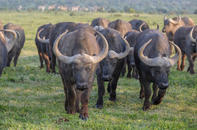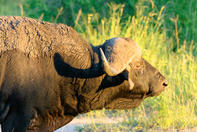Pathfinders
The movements of a herd of buffalo are determined by specific individuals known as ‘pathfinders’. These are not necessarily dominant animals but they simply act as leaders to the herd.

Each sub-herd within the major herd also has a pathfinder which will lead its members when the herd splits up.
Due to the necessity to find suitable grassy pastures and water on an ongoing basis, buffalo are not territorial although they do move within more familiar home ranges which more-or-less excludes other buffalo herds. Home ranges expand or shrink depending on the shortage or availability of resources respectively.
Dagga Boys

Very old buffalo bulls that have passed their reproductive peak (from ten years old) are usually found alone or in small groups. These animals are sometimes nicknamed ‘dagga-boys’. Dagga is the Zulu word for mud and refers to their pastime of wallowing in water or mud.
These individuals often have skin diseases or old battle wounds and it is believed that the water and mud helps to soothe these aches and pains. Food surrounding the localized waterholes that they frequent is also likely to be softer and more easily digested.
These animals lack the protection of a herd and are susceptible to attacks from lions. The cumulative result is that dagga-boys are extremely temperamental and dangerous if approached on foot.
By Megan Emmett